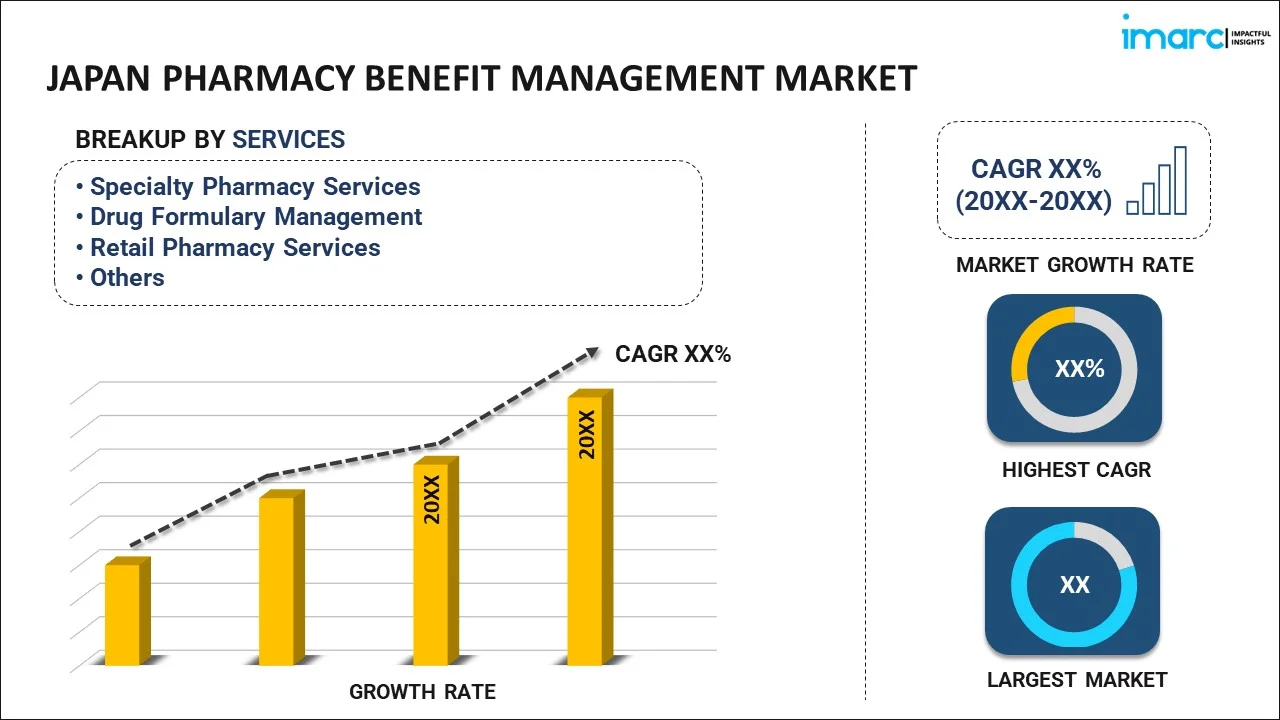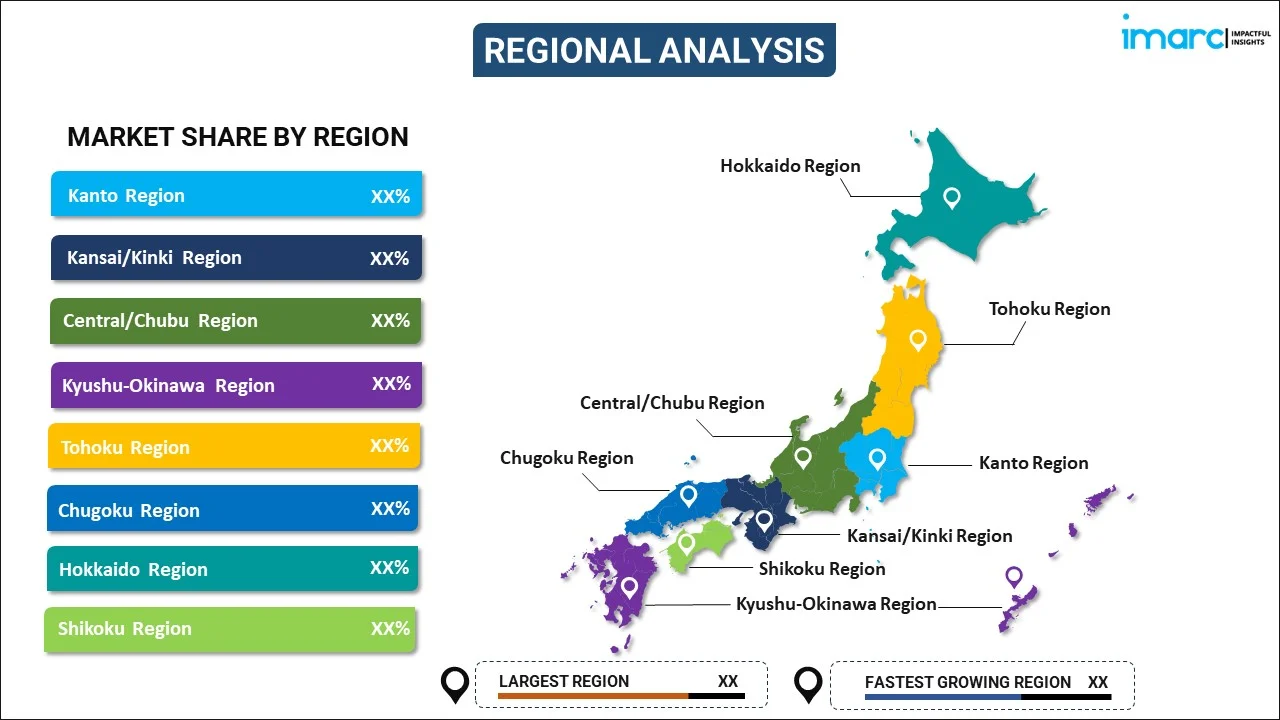
Japan Pharmacy Benefit Management Market Report by Service (Specialty Pharmacy Services, Drug Formulary Management, Retail Pharmacy Services, Benefit Plan Design and Consultation, Disease Management Services, and Others), Business Model (Health Insurance Management, Standalone PBMs, Retail Pharmacy), End Use (Federal, Commercial), and Region 2025-2033
Market Overview:
Japan pharmacy benefit management market size reached USD 35,659 Million in 2024. Looking forward, IMARC Group expects the market to reach USD 55,738 Million by 2033, exhibiting a growth rate (CAGR) of 5.1% during 2025-2033. The market is being driven by the increasing demand for cost-effective management of prescription medications and the incorporation of machine learning (ML) and artificial intelligence (AI) technologies.
|
Report Attribute
|
Key Statistics
|
|---|---|
|
Base Year
|
2024 |
|
Forecast Years
|
2025-2033
|
|
Historical Years
|
2019-2024
|
| Market Size in 2024 | USD 35,659 Million |
| Market Forecast in 2033 | USD 55,738 Million |
| Market Growth Rate (2025-2033) | 5.1% |
Pharmacy benefit management (PBM) refers to the third-party entities that administer prescription drug programs on behalf of health insurance plans, employers, and other organizations. It plays a crucial role in managing and optimizing the pharmaceutical benefits provided to plan members or employees. Pharmacy benefit management acts as intermediaries between pharmacies, drug manufacturers, and healthcare payers, facilitating the effective and efficient delivery of prescription medications. It performs various functions, including negotiating drug prices with pharmaceutical companies, developing, and maintaining formularies, processing prescription claims, and managing pharmacy networks. Pharmacy benefit management aims to control prescription drug costs, promote generic drug utilization, ensure medication safety, and improve overall health outcomes.
Japan Pharmacy Benefit Management Market Trends:
In the Japan market, the driving force behind its growth lies in the imperative need for effective management of prescription drug costs. Additionally, the increasing pricing of medications has intensified the demand for pharmacy benefit management (PBM) services among health insurance providers, creating attractive opportunities for market expansion. Furthermore, the presence of similar drugs with slight variations in their active pharmaceutical ingredients (API) has heightened price sensitivity among consumers, resulting in a heightened demand for PBM services. Furthermore, the incorporation of machine learning (ML) and artificial intelligence (AI) technologies has played a pivotal role in enhancing operational efficiency. These technologies have streamlined supply chain processes, facilitated swifter order delivery, and catered to multiple insurance and retail pharmacy chains within limited timeframes. Additionally, there is a noticeable shift towards pharmacy benefit management systems due to their capacity to provide enhanced expertise and establish connections with leading companies. Furthermore, ongoing enhancements and the increasing availability of healthcare data are instigating significant transformations within the regional market. Apart from this, PBMs are harnessing the potential of data analytics, artificial intelligence, and machine learning to offer more personalized, data-driven pharmacy benefit solutions, which is expected to fuel the market growth in the coming years.
Japan Pharmacy Benefit Management Market Segmentation:
IMARC Group provides an analysis of the key trends in each segment of the market, along with forecasts at the country level for 2025-2033. Our report has categorized the market based on service, business model, and end use.
Service Insights:

- Specialty Pharmacy Services
- Drug Formulary Management
- Retail Pharmacy Services
- Benefit Plan Design and Consultation
- Disease Management Services
- Others
The report has provided a detailed breakup and analysis of the market based on the service. This includes specialty pharmacy services, drug formulary management, retail pharmacy services, benefit plan design and consultation, disease management services, and others.
Business Model Insights:
- Health Insurance Management
- Standalone PBMs
- Retail Pharmacy
A detailed breakup and analysis of the market based on the business model have also been provided in the report. This includes health insurance management, standalone PBMS, and retail pharmacy.
End Use Insights:
- Federal
- Commercial
The report has provided a detailed breakup and analysis of the market based on the end use. This includes federal and commercial.
Regional Insights:

- Kanto Region
- Kansai/Kinki Region
- Central/ Chubu Region
- Kyushu-Okinawa Region
- Tohoku Region
- Chugoku Region
- Hokkaido Region
- Shikoku Region
The report has also provided a comprehensive analysis of all the major regional markets, which include Kanto Region, Kansai/Kinki Region, Central/ Chubu Region, Kyushu-Okinawa Region, Tohoku Region, Chugoku Region, Hokkaido Region, and Shikoku Region.
Competitive Landscape:
The market research report has also provided a comprehensive analysis of the competitive landscape. Competitive analysis such as market structure, key player positioning, top winning strategies, competitive dashboard, and company evaluation quadrant has been covered in the report. Also, detailed profiles of all major companies have been provided.
Japan Pharmacy Benefit Management Market Report Coverage:
| Report Features | Details |
|---|---|
| Base Year of the Analysis | 2024 |
| Historical Period | 2019-2024 |
| Forecast Period | 2025-2033 |
| Units | Million USD |
| Scope of the Report | Exploration of Historical Trends and Market Outlook, Industry Catalysts and Challenges, Segment-Wise Historical and Future Market Assessment:
|
| Services Covered | Specialty Pharmacy Services, Drug Formulary Management, Retail Pharmacy Services, Benefit Plan Design and Consultation, Disease Management Services, Others |
| Business Models Covered | Health Insurance Management, Standalone PBMs, Retail Pharmacy |
| End Uses Covered | Federal, Commercial |
| Regions Covered | Kanto Region, Kansai/Kinki Region, Central/ Chubu Region, Kyushu-Okinawa Region, Tohoku Region, Chugoku Region, Hokkaido Region, Shikoku Region |
| Customization Scope | 10% Free Customization |
| Post-Sale Analyst Support | 10-12 Weeks |
| Delivery Format | PDF and Excel through Email (We can also provide the editable version of the report in PPT/Word format on special request) |
Key Questions Answered in This Report:
- How has the Japan pharmacy benefit management market performed so far and how will it perform in the coming years?
- What has been the impact of COVID-19 on the Japan pharmacy benefit management market?
- What is the breakup of the Japan pharmacy benefit management market on the basis of service?
- What is the breakup of the Japan pharmacy benefit management market on the basis of business model?
- What is the breakup of the Japan pharmacy benefit management market on the basis of end use?
- What are the various stages in the value chain of the Japan pharmacy benefit management market?
- What are the key driving factors and challenges in the Japan pharmacy benefit management?
- What is the structure of the Japan pharmacy benefit management market and who are the key players?
- What is the degree of competition in the Japan pharmacy benefit management market?
Key Benefits for Stakeholders:
- IMARC’s industry report offers a comprehensive quantitative analysis of various market segments, historical and current market trends, market forecasts, and dynamics of the Japan pharmacy benefit management market from 2019-2033.
- The research report provides the latest information on the market drivers, challenges, and opportunities in the Japan pharmacy benefit management market.
- Porter's five forces analysis assist stakeholders in assessing the impact of new entrants, competitive rivalry, supplier power, buyer power, and the threat of substitution. It helps stakeholders to analyze the level of competition within the Japan pharmacy benefit management industry and its attractiveness.
- Competitive landscape allows stakeholders to understand their competitive environment and provides an insight into the current positions of key players in the market.
Need more help?
- Speak to our experienced analysts for insights on the current market scenarios.
- Include additional segments and countries to customize the report as per your requirement.
- Gain an unparalleled competitive advantage in your domain by understanding how to utilize the report and positively impacting your operations and revenue.
- For further assistance, please connect with our analysts.
 Inquire Before Buying
Inquire Before Buying
 Speak to an Analyst
Speak to an Analyst
 Request Brochure
Request Brochure
 Request Customization
Request Customization




.webp)




.webp)












